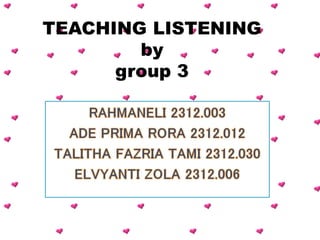Teaching listening
•Télécharger en tant que PPTX, PDF•
3 j'aime•2,524 vues
how to teach listening
Signaler
Partager
Signaler
Partager

Recommandé
Contenu connexe
Tendances
Tendances (20)
HD Brown's Principles for Teaching Listening Skills

HD Brown's Principles for Teaching Listening Skills
ENGLISH LANGUAGE TEACHING METHODOLOGY:Topic : Listening Skills

ENGLISH LANGUAGE TEACHING METHODOLOGY:Topic : Listening Skills
Similaire à Teaching listening
Similaire à Teaching listening (20)
Teach Listening-strategies and pre listening activities

Teach Listening-strategies and pre listening activities
Methodology information, about university students

Methodology information, about university students
Dernier
Dernier (20)
Biogenic Sulfur Gases as Biosignatures on Temperate Sub-Neptune Waterworlds

Biogenic Sulfur Gases as Biosignatures on Temperate Sub-Neptune Waterworlds
Biopesticide (2).pptx .This slides helps to know the different types of biop...

Biopesticide (2).pptx .This slides helps to know the different types of biop...
Nightside clouds and disequilibrium chemistry on the hot Jupiter WASP-43b

Nightside clouds and disequilibrium chemistry on the hot Jupiter WASP-43b
SAMASTIPUR CALL GIRL 7857803690 LOW PRICE ESCORT SERVICE

SAMASTIPUR CALL GIRL 7857803690 LOW PRICE ESCORT SERVICE
Pests of mustard_Identification_Management_Dr.UPR.pdf

Pests of mustard_Identification_Management_Dr.UPR.pdf
Chemical Tests; flame test, positive and negative ions test Edexcel Internati...

Chemical Tests; flame test, positive and negative ions test Edexcel Internati...
Botany krishna series 2nd semester Only Mcq type questions

Botany krishna series 2nd semester Only Mcq type questions
Formation of low mass protostars and their circumstellar disks

Formation of low mass protostars and their circumstellar disks
Forensic Biology & Its biological significance.pdf

Forensic Biology & Its biological significance.pdf
GUIDELINES ON SIMILAR BIOLOGICS Regulatory Requirements for Marketing Authori...

GUIDELINES ON SIMILAR BIOLOGICS Regulatory Requirements for Marketing Authori...
Teaching listening
- 2. MICRO AND MACRO SKILLS OF LISTENING COMPREHENSION
- 3. • Process speech containing pauses, errors, corrections, and other perfomance variables • Recognize grammatical words classes (nouns, verbs, etc), system (e.g tense, agreement, pluralization) , patterns, roles, and elliptical forms. • Detect sentence constituents and distinguish between major and minor constituents • Recognize that a particular meaning may be expressed in different grammatical forms • Recognize cohesive devices in spoken discourse
- 4. MACRO SKILLS • Recognize the communicative functions of utterences according to situations, participant, goal • Infer situations, participants, goals using real-word knowledge • Form events, ideas and so on, described, predict outcomes infer links and connections between events, deduce causes and effects and detect such relation as main ideas, supporting ideas, new information, given information, generalization, and ex emplification • Distinguish between literal and implied meanings • Use facial, kinesic, body language, and other nonverbal clues to decipher meanings • Develops and use a battery of listening strategies, such as detecting keywords, guessing the meaning of word from context, appealing for help and signaling comprehension or lack thereof
- 6. 2. Expose students to different types of listening 3. Teach a variety of task 4. Consider text, difficulty and authenticity. • Task authenticity • Input authenticity 5. Teaching listening strategies
- 7. According to Harmer’s book principle of teaching listening as follow :1. Encourage students to listen as often and as much possible The more students listen, the better they get at listening - and the better they get at understanding pronunciation and at using it appropriately themselves. One of our main tasks, therefore, will be to use as much listening in class as possible, and to encourage students to listen to as much English as they can (via the Internet, podcasts, CDs, tapes, etc). 2. Preparation is vital Students need to be made ready to listen. This means that they will need to look at pictures, discuss the topic, or read the questions first, for example, in order to be in a position to predict what is coming. This is not just so that they are in the right frame of mind (and are thinking about the topic), but also so that they are engaged with the topic and the task and really want to listen.
- 8. 3. Once will not be enough • the first listening is often used just to give students an idea of the listening material sound like 4. Students should be encouraged to respon to the content of a listening, not just to the language. • The most important part of listening practice is to draw out the meaning 5. Different listening stages demand different listening tasks. • A first listening, the task needs to be fairly straight forward and general, focus in on detail-of information language use. 6. Good teacher explaint listening texts to the full • Ask students invest time and emotional energy in a listening task.
- 9. Classroom Listening Activity 1. Not overt response • stories, tell a joke or real life anecdote, retell well known story, read story from a book, play a recording of a story. • Songs, sing a song of your self, play a recording of one • Enterntainment, film teathre, video
- 10. 2.
- 11. 3. Longer responses • Answering question, one or more question demanding fairly full responses are given in advance, to which listening text provides the answers because of the relatives length of the answers demanded • Note taking, take brief notes from a short lecture or talk • Paraphrasing and translating, leaners rewrite the listening text in different words • Summarizing, leaners write a brief summary of the content passages • Long gap feeling, a long gap is left at the beginning middle or and of end text
- 12. 4. Extended reponse • Problem soving, learners discuss how to deal with. Or write down a suggested solution • Interpretation, an extract from a pieces a dialogue or monologue are provided with no previous information
